#ryukyu onsen
Text
12 Top Places to Visit in Our Japan Tour Packages from India

Embarking on a journey to Japan from India is an adventure filled with cultural immersion, culinary delights, and awe-inspiring landscapes. With our Japan tour packages from India, you have the opportunity to explore some of the country's most iconic and captivating destinations. Here are 12 top places to visit, ensuring an unforgettable experience that showcases the best of Japan.
Tokyo: As the bustling capital city of Japan, Tokyo is a must-visit destination included in our Japan tour packages from India. Explore vibrant neighborhoods like Shibuya and Shinjuku, visit iconic landmarks such as the Tokyo Tower and Meiji Shrine, and immerse yourself in the city's dynamic culture and cutting-edge technology.
Kyoto: Known for its traditional temples, serene gardens, and historic districts, Kyoto is a cultural treasure trove waiting to be explored. With our Japan tour packages from India, you can visit iconic sites like Kinkaku-ji (Golden Pavilion), Fushimi Inari Shrine, and Arashiyama Bamboo Grove.
Osaka: Osaka is a vibrant city known for its delicious street food, lively entertainment districts, and historic landmarks. Our Japan tour packages from India offer the opportunity to explore attractions like Osaka Castle, Dotonbori Street, and Universal Studios Japan.
Hiroshima: Hiroshima is a city with a powerful history and a resilient spirit. Visit the Hiroshima Peace Memorial Park and Museum, pay tribute to the victims of the atomic bombing, and explore the historic streets of Hiroshima with our Japan tour packages from India.
Nara: Home to some of Japan's oldest and most significant temples, Nara is a city steeped in history and spirituality. With our Japan tour packages from India, you can visit Todai-ji Temple, home to the Great Buddha statue, and wander through Nara Park, where friendly deer roam freely.
Mount Fuji: No trip to Japan is complete without a visit to Mount Fuji, the country's tallest peak and a symbol of natural beauty. Our Japan tour packages from India offer the opportunity to admire Mount Fuji from various viewpoints, including Lake Kawaguchi and the Fuji Five Lakes region.
Hakone: Hakone is a scenic town known for its hot springs, stunning views of Mount Fuji, and traditional ryokan (Japanese inns). With our Japan tour packages from India, you can soak in the therapeutic waters of an onsen, ride the Hakone Ropeway for panoramic views, and cruise on Lake Ashi.
Hokkaido: Hokkaido is Japan's northernmost island, known for its pristine nature, outdoor activities, and delicious seafood. Our Japan tour packages from India offer the opportunity to explore attractions like Sapporo, Otaru Canal, and the breathtaking Shiretoko National Park.
Nikko: Nikko is a UNESCO World Heritage Site renowned for its stunning shrines, temples, and natural beauty. With our Japan tour packages from India, you can visit Toshogu Shrine, Rinno-ji Temple, and the picturesque Kegon Falls, surrounded by lush forests and scenic vistas.
Kanazawa: Kanazawa is a city celebrated for its rich cultural heritage, traditional crafts, and beautifully preserved samurai districts. Our Japan tour packages from India offer the opportunity to explore attractions like Kenrokuen Garden, Kanazawa Castle, and the Higashi Chaya District.
Koyasan (Mount Koya): Koyasan is a sacred mountain retreat and the spiritual heart of Shingon Buddhism in Japan. With our Japan tour packages from India, you can stay overnight in a temple lodging (shukubo), experience morning prayers, and explore the serene forested surroundings.
Okinawa: Okinawa is a tropical paradise known for its stunning beaches, vibrant coral reefs, and unique Ryukyu culture. Our japan tours from india
offer the opportunity to relax on pristine sands, snorkel in crystal-clear waters, and visit historic sites like Shuri Castle.
In conclusion, our japan tours from india
offer a comprehensive exploration of the country's top destinations, ensuring an enriching and unforgettable travel experience. Whether you're exploring the bustling streets of Tokyo, admiring the natural beauty of Mount Fuji, or immersing yourself in the rich cultural heritage of Kyoto, Japan has something to offer every traveler. So why wait? Book your Japan tour package today and embark on the adventure of a lifetime.
#Japan tour packages from india#japan packages from india#japan tour from india#japan tour packages#japan travel packages
1 note
·
View note
Text
Menso-re, Okinawa!
Okinawa, the southernmost prefecture of Japan, can be reached by a three-hour flight from Tokyo. It was the first time for us to come here and we decided to explore the main island only. The trip started from Kokusai Dori Street. The street is the main street in Naha, where you can find many restaurants and shops. We had steak for lunch from steak house 88, a famous steak house chain in Okinawa. And Blue Seal Ice Cream to beat the heat of the weather.

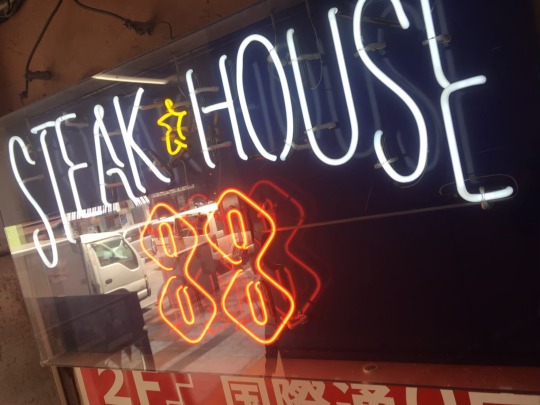
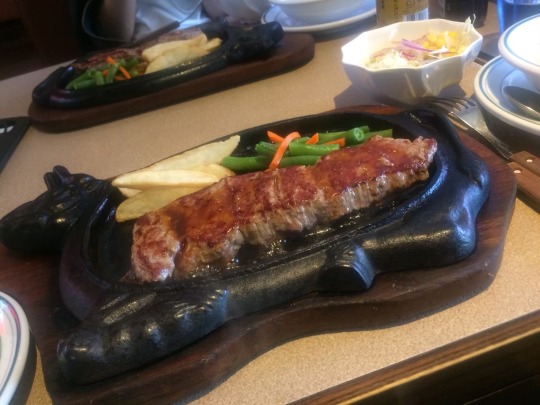

The rest of the afternoon, we spent our time on Ryukyu Onsen. Of course, we did not stay there, we only enjoyed the Onsen. :p
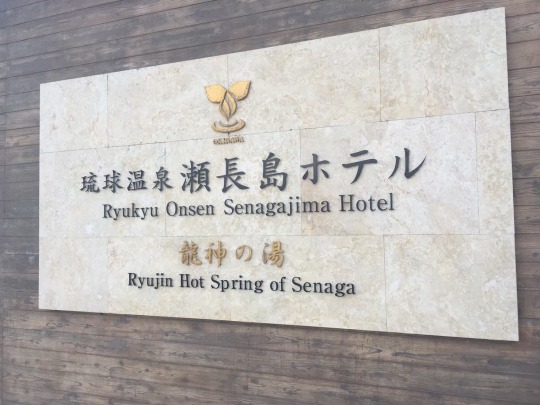
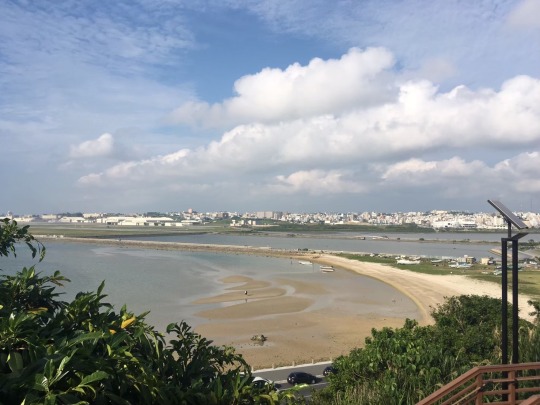

On the second day, we went to Naminoue Beach for snorkeling and tried local Okinawan food. If we are talking about Okinawan food, most of them are pork and it was so good! Goya (bitter gourd), Umi-budo (sea grapes), and Beni-imo (purple sweet potato) are must to try!







On the last day, we went to Churaumi Aquarium. Churaumi Aquarium is considered one of the biggest and best aquariums in the world. Chura means beautiful in the local Okinawan dialect and Umi means sea in Japanese, so Churaumi means a beautiful sea that fits as a description of the natural beauty surrounding it. A huge water tank inside, entitled Kuroshio Sea, is home to popular whale sharks and giant manta rays.
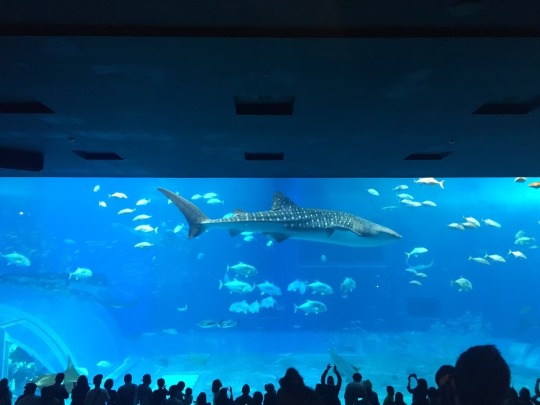


#japan#japan travel#okinawa#okinawa trip#kokusai dori#kokusai dori street#steakhouse 88 okinawa#blue seal ice cream#ryukyu onsen#naminoue beach#okinawa snorkeling#okinawa food#goya#bitter gourd#umibudo#sea grapes#beni imo#purple sweet potato#churaumi aquarium
0 notes
Photo

Usually, when the distractions of daily life deplete our energy, the first thing we eliminate is the thing we eliminate is the thing we need the most: quiet, reflective time. Time to dream, time to contemplate what's working and what's not, so that we can make changes for the better. - Sarah Ban Breathnach
👕 Addison Jacket & Crop Top - *B.D.R.*
👕 Bianca Shorts - *B.D.R.*
Available at the *B.D.R.* Mainstore
*B.D.R.* on Marketplace
👩 Sexy Lady - Chloe Poses
Available at .::Chloe Poses::. Mainstore
.::Chloe Poses::. on Marketplace
🥚 Black Egg Statue and Character - [Mamere]
Available from the RyuKyu Onsen Event until 17 Feb
[Mamere] Mainstore
[Mamere] on Marketplace
#SecondLife#BDR#BeautifulDirtyRich#Mamere#Chloe#Chloeposes#clothing#clothes#fashion#style#decor#garden#home#home&garden#pose#poses#posed#bento#animation#avatar#event#blogging#quiet#comtemplation#cute#character
0 notes
Text
Okinawa Urban Resort "HOTEL SANSUI NAHA" Is Now Open!
【New Post】Okinawa Urban Resort "HOTEL SANSUI NAHA" Is Now Open!
#Okinawa
#JapanTravel
Okinawa Urban Resort “HOTEL SANSUI NAHA” Is Now Open!
Resorts Ryukyu Co., Ltd. opend its 10th hotel “HOTEL SANSUI NAHA Ryukyu Onsen Naminoue no Yu” on February 1.
Located in historical site
“HOTEL SANSUI NAHA” is about 10 minutes by car from Naha Airport through the Umisora tunnel. The hotel is located in a historic location that welcomed many people as a gateway to trade with countries…
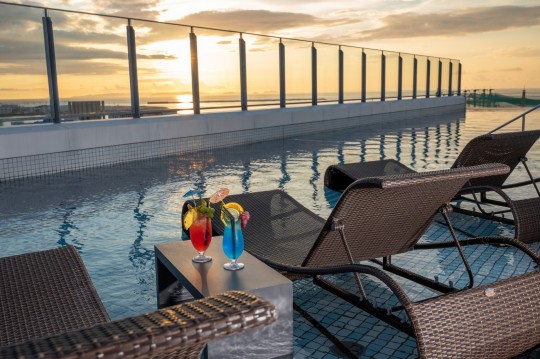
View On WordPress
0 notes
Photo
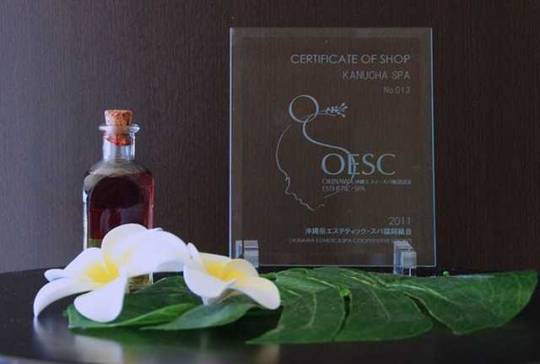

An Array Of High-Level Spas! 3 Healing Retreats To Try In Okinawa!
We will introduce three spas you’ll want to stop by on your Okinawa trip. Kanucha Spa, Ryukyu Onsen Ryujin no Yu, and CREER DU Qi Ocean Spa are influential facilities that were chosen as part of the top 10 spas in Japan in the Crystal Awards.
https://matcha-jp.com/en/5000
4 notes
·
View notes
Text
Okinawa

Yesterday was our final day in Okinawa and in the short time we spent there so much transpired. The one thing that immediately caught my eye was how completely different Okinawa feels compared to that of mainland Japan. It’s clear that the American influence plays a big role, yet the islanders hold on to their distinct heritage in a very beautiful way. There were simple differences, really, yet so significant. Take the language, for instance. You often hear people in Tokyo mentioning how Okinawans speak a different dialect of Japanese. What I didn’t realize is a lot of the traditional way of speaking is almost its own language altogether. While they share many of the same customs as the mainland, they also have their own. Let me begin with why we went to Okinawa in the first place, apart from the fact that it’s been on our bucket list of places to go. The purpose of this trip was for Rob, myself, and our friend Naoki to deliver a seminar to JTEs (Japanese Teachers of English). Our friend and fellow colleague, Taniguchi-sensei (or “Grandpa” as we call him) is a well known organizer for these seminars and managed to book the trip for the four of us. We shared a presentation on “How to Team Teach with Foreigners” in the hopes of providing a new perspective to the JTEs. After meeting with all of the teachers and locals during our trip, we can say for certain that there is one thing Okinawa shares with mainland Japan and that is their warm hospitality, or omotenashi as they say in Japan.
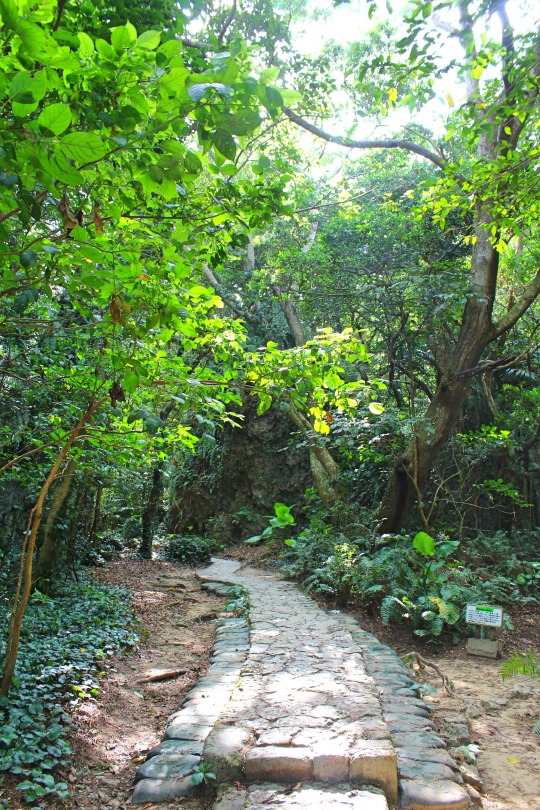

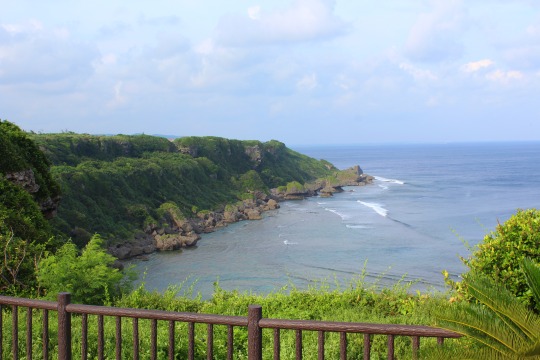
DAY 1
Our first day was reserved for visiting some of Okinawa’s world heritage and memorial sites. The first place we toured was called Sefa-utaki, the historical origin sites of the Ryukyu Islands. Walking through the forested area and gazing at the monstrous rocks where pilgrims often travel to pray brought out a very spiritual feeling to us as observers. Shortly thereafter, we drove to the Peace Memorial for a private tour and a bit of history about the events that unfolded during the Battle of Okinawa in April of 1945. We were especially moved by the fact that the walls with engraved names of the dead included Japanese, Okinawan, and American military personnel. The cliff pictured above shows a beautiful view of where nature’s greenery meets the ocean-blue waves. During the intense battles that took place here, the locals were essentially pushed off the edge and forced to commit suicide against their will. At that time, the water was completely red from the blood of those who died. We took a few moments and all prayed together. It was quite beautiful and honestly what we hope our ancestors and countrymen would have wanted as a result from the war.
Nearby the Peace Memorial is another memorial called Himeyuri that had another very emotional impact. The site is dedicated to an Okinawan girl’s school that had suddenly been forced to become participants during the battle. These girls had to drop their books and pick up medical supplies to aid the injured Japanese soldiers. As a result of the battle, almost all of the 222 girls lost their lives. I encourage everyone to learn about their story as it’s a truly tragic one. Girls as young as 12-years-old went into the underground caves where the Japanese military required them to care for the injured. They weren’t allowed to return to their families and eventually most of them died from various causes. They’re known as the Himeyuri students.

Our first night out took a thrilling turn. What seemed like any normal Japanese-style restaurant turned out to be anything but ordinary. The restaurant included live music and portrayed a perfect example of Okinawan-style cuisine. We tried pig’s feet, Sōki soba (Okinawa’s famous noodle dish), as well as umibudou (or seaweed grapes, which had no particular flavor but a very interesting texture), and then washed it all down with an ice cold Okinawan brewed Orion beer. The music consistently involved the audience in singing along, dancing around the restaurant together and giving a cheers to your neighbor by shouting “ari-kanpai”. As if things weren’t exciting enough, we then took to the stage for a chance to try on traditional Ryukyu royalty attire (pictured above).
DAY 2
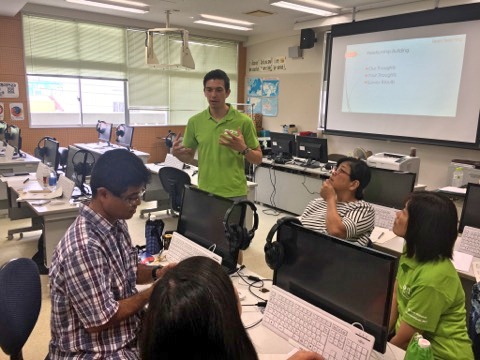
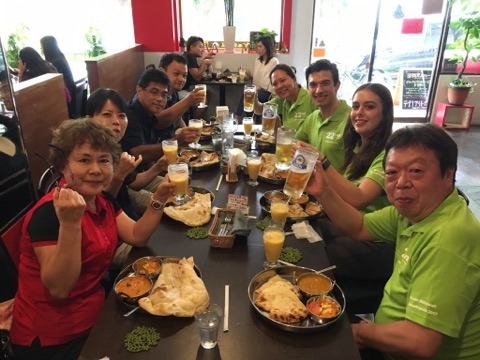
Our first seminar went exceptionally smoothly and we really connected with the teachers who had attended. Once the seminar came to a close for the day, we went out for a night of drinking and learning about Okinawan local life. One of the teachers played the sanshin (an Okinawan banjo-like instrument) as we all sang the local tunes at an anime-style karaoke bar. The night ended at a Showa era jazz bar with a very talented guitarist, where we sang old-style Japanese karaoke (no TV prompter). We spent the majority of the time drinking awamori (popular local spirits) and talking with our new local friends.
DAY 3
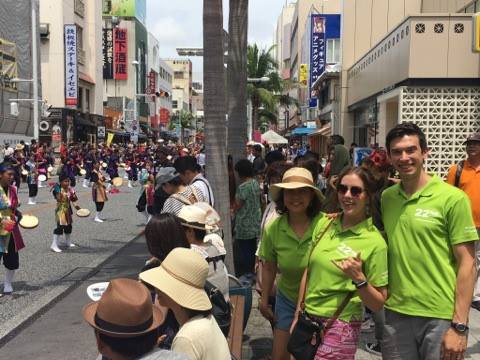

Following our final day of presenting (including a taco lunch and local parade), we joined everyone for a sunset beach BBQ. We gathered by the water, drinks in our hand, as we took in the beautiful view of the ocean and cooked up various meats. What we hadn’t anticipated was the sudden change in weather. We started the BBQ with beautiful skies and a slight breeze in the air. Then, suddenly the storm decided to swoop in. The sky went grey as thunder and lightning boomed overhead. Rain began pouring in a monsoon-like way as the wind blustered through, blowing away our cups and plates. Soon after, a staff member came by to evacuate us as the storm was in full force. The group of us grabbed our belongings and took off towards shelter in a nearby resort hotel lobby. It was like something out of a movie. We sprinted through the rain as the wind gusted this way and that. Moments later we had safely arrived to shelter beneath the nearby hotel. The same staff member provided us towels to dry our soaking wet bodies, reimbursed us for the BBQ, and it was then that we realized some of the guys had carried their beers with them through the storm. We all busted into laughter at this realization and the mere luck of the typhoon hitting us so suddenly in that moment.
DAY 4

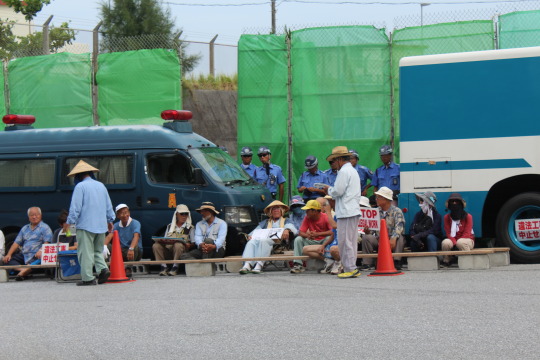

Day 4 was yet another impactful day. As you may know, Okinawa has an abundance of U.S. military bases throughout the island. What you may not know is how exactly this impacts the locals. Whether it be the osprey that crashed (disrupting local life), the rape and murder of a high school girl, or the drunk driving from American military personnel, it’s clear that the military presence has an impact on the Okinawan people. In addition to all this, the Japanese government is currently in the works of a new plan to build a U.S. base on the shores of Henoko (a region in Okinawa). We had an opportunity (thanks to the help of our new friend and local university instructor, Keiko-sensei) to go speak with the protesters about what they’re opposing to try and grasp a better understanding of their cause.
LET ME BE CLEAR THAT WE WERE IN NO WAY INVOLVED IN THE PROTEST, BUT MERELY THERE TO OBSERVE AND TALK WITH THE ACTIVISTS TO EXCHANGE THOUGHTS.
As it seems, the new base where the construction has began is not only endangering the ocean-life and surrounding natural habitats, but the locals feel they’re having their land stolen right under their feet. It was really powerful to see how passionate they are about their heritage, people, and land. It reminds me a bit of how the Native Americans feel about their land in the states and having to then fight for what is rightfully theirs. After speaking with the protesters, they had asked us each to say a little something and next thing I know I’m singing the song “Imagine” by John Lennon to a group of protesters in Okinawa as the U.S. military is gazing at us only a few yards away. It was a very surreal and eye-opening experience.
DAY 5
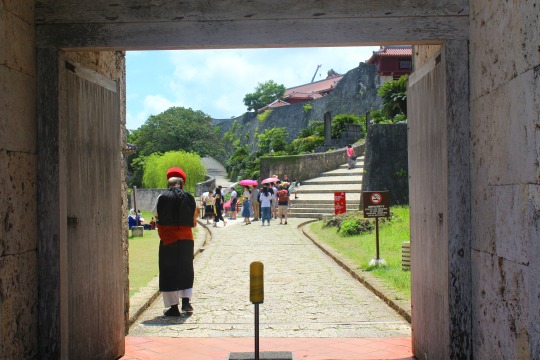




The biggest take away from this trip is that we as people cannot bundle a society or country of people into one category. If you meet one American, can you honestly say you fully understand American culture from that one person? Certainly you cannot and the same is to be said about Japan. Okinawa is it’s own brand and a place we hope to visit again in the future, along with some of it’s neighboring islands. Our final day was spent sightseeing, shopping, and going to an ocean-view onsen (or hot spring). We would just like to thank Takara-sensei (see you in Seattle next March), Seiko-sensei, Seigo-sensei, Keiko-sensei, Gaku-sensei, Yoko-sensei, and the rest of the Okinawan crew of teachers! You all made our trip so very special and we’ll truly never forget it. A special shout out to Naoki and Grandpa (Taniguchi-sensei) for being such remarkable travel partners. Thanks to Grandpa for making this whole trip happen and being “the best of the best”. We are so incredibly lucky to know you all and feel very blessed to have such wonderful people in our lives. あり乾杯!
4 notes
·
View notes
Photo

9月の最終週は #宮古島 にいながら #台風 のせいで #ダイビング できなかっただけでなく、一度も海に入れなかったので #シギラ黄金温泉 で過ごした。 #沖縄 #琉球 #シギラリゾート #温泉 #プール #台風24号 #旅 #旅行 #japan #okinawa #ryukyu #miyakojima #shigiraresort #shigira #onsen #spa #pool #typhoon #trip #travel (シギラ黄金温泉) https://www.instagram.com/p/BpA2pqBBZh9/?utm_source=ig_tumblr_share&igshid=16oz80e2rpdoc
#宮古島#台風#ダイビング#シギラ黄金温泉#沖縄#琉球#シギラリゾート#温泉#プール#台風24号#旅#旅行#japan#okinawa#ryukyu#miyakojima#shigiraresort#shigira#onsen#spa#pool#typhoon#trip#travel
0 notes
Text
10 อันดับโรงแรมบนเกาะโอกินาว่า ใกล้แหล่งท่องเที่ยว พร้อมที่จอดรถฟรี!
หลังจากที่ Topofhotel ได้ทำการรีวิวโรงแรมในเมืองนาฮา (Naha) ไปในรีวิว “10 อันดับโรงแรมในโอกินาว่า (OKINAWA) ใกล้รถไฟฟ้า กลางแหล่งช็อปปิ้ง” มีหลายๆท่านเรียกร้องกันมาให้ทำรีวิวโรงแรมที่อยู่นอกเมืองบ้าง วันนี้ Topofhotel.com จึงได้จัดทำรีวิว
” 10 อันดับโรงแรมบนเกาะโอกินาว่า ใกล้แหล่งท่องเที่ยว พร้อมที่จอดรถฟรี ! “
แหล่งท่องเที่ยวชื่อดั���ของโอกินาว่า (Okinawa) คือ…
View On WordPress
#airbnb okinawa pantip#airbnb โอกินาว่า#american village okinawa รีวิว#Centurion Hotel Okinawa Churaumi#Condominium Hotel Monpa#Hilton Okinawa Chatan Resort#Hotel Mahaina#Hotel Mahaina Wellness Resorts Okinawa#hotel ocean okinawa รีวิว#Hotel Orion Motobu Resort & Spa#Kafuu Resort Fuchaku Condo Hotel#Mihama American Village#Moon Ocean Ginowan Hotel & Residence#okinawa#okinawa onsen#okinawa พักแถวไหนดี#okinawa มีออนเซนไหม#ryukyu onsen senagajima hotel#Vessel Hotel Campana Okinawa#Wisteria Condominium Resort#Yukurina Resort Okinawa#Yukurina Resort Okinawa Urizun#จอดรถฟรี#ที่พัก โอ กิ นา ว่า airbnb#ที่พัก โอ กิ นา ว่า ออ น เซ็น#ที่พัก โอกินาว่า#ที่พัก โอกินาว่า จอดรถ#ที่พัก โอกินาว่า จอดรถฟรี#ที่พัก โอกินาว่า มี่ที่จอดรถ#ที่พัก โอกินาว่า ออนเซ็น
0 notes
Text
Must-to-do adventure activity in Japan – #tripstations
Japan is an island nation which is one of the most visited in the Pacific region. It offers adventure tourists many such destinations for them to explore. Japan has an outdoor activity for all its visitors be it for Skiing, Mountain Climbing, Beaches and Islands, Drift Ice and Sports events, Japan offers them all. In 2020, Japan hosts the 2020 Summer Olympics and in the year 2018, Japan hosted the 2018 Winter Olympics where we can get to know how this island nation is a sports-friendly and also has both the conditions for Summer as well as Winter gaming competition.
If you wish to explore Japan, Adventure wise we recommend you some of the must-to-do adventure activity here.
1) Yakushima National Park: Yakushima National Park is located in the protected area of Kagoshima Prefecture, Kyshu. It is a part of Yakushima Island and some parts of Osumi Islands and entire Island of Kuchinoerabu-Jima which covers total area size of 325.53 sq km. It is a protected national park which is known for its hiking trails. Some of the mountains present here can be climbed as some are considered Sacred according to the Japanese and these are barred from climbing. The park is surrounded by marine life and is this park is the place where Hawksbill Sea Turtle comes in Summer to lay eggs. Towards the southwestern region, there are exotic wildlife and coral reefs. The Island is known for having species of Japanese Macaque and endangered species of Ryukyu flying fox. The place is said to be having around 1900 plant species, 16 mammal species and 150 bird species.
2) Yoshida Trail, Mount Fuji: Known to be one of the largest peaks of Japan, Mount Fuji is located in Honshu and is considered one of the three holy mountains along with mount tate and mount haku. It is one of Japan’s historic sites and is one of the most preferred mountains for mountaineers to climb. The Yoshida Trail is one of the ancient routes to climb the mountain and is one of the difficult routes to explore. It is an 18.7 km trail which has some of the scenic views and beautiful wildflowers on the way. At the main trail entrance to Umagaeshi, you will be greeted by a pair of stone monkeys guarding the gate. The trail is accessible from July to September.
3) Mount Zao: Mount Zao is located near the border between Yamagata Prefecture and Miyagi Prefecture. It is a cluster of strato-volcanoes and is one of the most active in the region of Honshu. Mount Zao is known for its ski resorts, snow monsters which are formed mid-winter and the place where you can enjoy skiing. There is a large ski-resort that provides 17 ski slopes where they offer courses from late December to the end of April. There are various lifts, ropeways to take you to the tip and various courses will be held based on beginners, intermediate and advanced levels. After the busy courses, you can rest at one of 3 public baths or Onsen as it is called in Japan. Zao is considered to have one of the oldest onsen towns in Japan.
4) Pinaisara Falls: Located in remote regions of Iriomote Islands, Pinaisara Falls is one of the highest waterfalls in Okinawa region. It is known for its adventure where you have kayaking and trekking options. Iriomote is known for its wild adventure in Japan due to this. You can kayak through the mangrove forests on the Mare and Hinai rivers to the falls or you can spend the day exploring the unexplored regions of North of Iriomote Island. Pinaisara means old man’s beard in Okinawan, and standing on top of the waterfall provides you with the scenic view of the Island along with Hatoma, Barasu, and Hatobanare islands out to sea. You can also swim in the falls basin. There are various tour operators who operate day tour of the Island and it generally costs 100US$ for adults and 92US$ for children. Kindly check with the tour operator if you have children accompanying you as they might have varying age restrictions.
5) Drift Ice Walks: Walk on the famous Okhotsk Sea’s drift where you get a thrilling experience to walk over the frozen sea. This experience is a must for thrill-seekers as this provides adrenaline-filled adventure. If you want to explore more adventurous you can take a dip or go scuba diving in the icy cold ocean. Okhotsk Sea is located in the northernmost region of Japan and walking tour takes place from February to Mid March depending on the ice conditions. Walking tour starts from 45-50US$ where you will be provided with protective gears.
Apart from the rest, you can find various kayaking, island hopping, canoeing experiences in Japan which is a place for adventure enthusiasts. Depending on the adventure which you want to travel and weather conditions plan and explore the beautiful nation of Japan.
The post Must-to-do adventure activity in Japan – #tripstations appeared first on Tripstations.
from Tripstations https://ift.tt/37oi1QA
via IFTTT
0 notes
Text
Những địa điểm du lịch Nhật Bản hấp dẫn năm 2018
Nhật Bản đã quá quen thuộc với người dân mỗi chúng ta với những hình ảnh kiếm sĩ Samurai, những cô đào Geisha duyên dáng hay những nét văn hóa ẩm thực đa dạng với các món Sushi tuyệt vời cùng loại rượu Sake hảo hạng. Những ai lần đầu đến Nhật Bản chắc chắn sẽ không thể nào bỏ qua những địa điểm du lịch hấp dẫn nhất tại Nhật Bản dưới đây. Cùng sotaydulich.net đi tìm hiểu những địa điểm du lịch đẹp này của Nhật Bản để chuẩn bị cho chuyến đi của bạn nhé.
Top địa điểm du lịch Nhật Bản đáng để đi nhất
Hồ Happo - tỉnh Nagano
[caption id="attachment_428" align="aligncenter" width="768"] Hồ Happo[/caption]
Nơi này được du khách và người dân bản địa ví von là miền tiên cảnh thanh tịnh giữa trần thế ồn ào của Nhật Bản. Tuy có diện tích khá nhỏ, hồ Happo lại cao đến 2.060m so với mực nước biển và được bao bọc bởi các rặng núi cao hơn 3.000m, chính điều này khiến mặt hồ luôn yên tĩnh và phẳng lặng. Cảm giác từ độ cao, này bạn được tĩnh tâm cảm nhận, ngắm nhìn mặt hồ bình yên giữa mây trời thoáng đãng, núi rừng xanh thẳm hẳn là khiến cho bạn dễ tìm thấy sự cân bằng trong tâm hồn và hòa hợp với cuộc sống. Con đường dẫn đến hồ Happo từ ngôi làng trượt tuyết Hakuba được coi là một trong các đường leo núi đẹp nhất ở xứ sở hoa anh đào.
Núi Phú Sĩ
[caption id="attachment_429" align="aligncenter" width="768"] Núi Phú Sĩ[/caption]
Được công nhận là Di sản văn hóa thế giới, đây là ngọn núi cao nhất trong “Ba núi Thánh”. Người dân nơi đây quan niệm ngọn núi này đem đến sự tốt lành, may mắn cho người dân Nhật Bản. Núi Phú Sỹ là ngọn núi lửa dữ dội đã ngừng hoạt động nhiều thiên niên kỷ trước. Với đỉnh chóp núi đẹp tuyệt vời cùng 5 hồ nước ngọt lớn dưới chân núi đã tạo nên một bức tranh thiên nhiên hoàn hảo. Nhật Bản không có núi Phú Sỹ cũng như tựa như nước Mỹ không có tượng “Nữ thần tự do” vậy, hay nói cách khác, đây được coi là hình ảnh biểu tượng của Nhật Bản cùng với hình ảnh hoa anh đào. Hành trình leo núi Phú Sỹ ngắm cảnh mặt trời mọc và bức tranh sơn thủy đẹp mơ màng xung quanh luôn thúc đẩy đông đảo người dân bản địa và cả du khách toàn thế giới xin visa Nhật Bản và khám phá.
Công viên ven biển Hitachi
[caption id="attachment_427" align="aligncenter" width="768"] Công viên ven biển Hitachi[/caption]
Đây là một trong những địa điểm du lịch rất được yêu thích ở Nhật Bản. Với diện tích rộng lớn hơn 3,5 ha, công viên Hitachi được khen là thiên đường hoa với nhiều sườn đồi được phủ hoa rực rỡ quanh năm. Hè về, hơn 4000 bông hoa thuộc 140 giống khác nhau cùng khoe sắc. Thu đến, là mùa của những bụi cây đổi màu Kochia mạnh mẽ chuyển màu đỏ thắm. Đông sang, những bông tulip ấm áp nở rực giữa buốt giá. Nhưng công viên lộng lẫy nhất vẫn là vào mùa xuân, khi hơn 4,5 triệu bông hoa “Nemophila – tình yêu bé nhỏ” nở xanh ngút ngàn thuần khiết dọc các triền đồi, tựa như cả bầu trời thiên thanh đang sà dần xuống ôm trọn cả một vùng đất. Ngoài ra, công viên còn có thêm một công viên giải trí nhỏ, 1 vòng đu quay lớn và những con đường mòn nhỏ xinh cho cả người đi xe đạp và đi bộ.
Vườn hoa tử đằng Kawachi - tỉnh Fukuoka
Hoa tử đằng được người Nhật Bản coi là biểu tượng của tình yêu vĩnh cửu, vì có thể phải đợi đến 15 năm để ngắm loài hoa này bung nở. Vào tháng 4 hàng năm, vườn hoa tử đằng Kawachi ở tỉnh Fukuoka trở nên vô cùng rực rỡ sắc màu vì hàng chục loài hoa tử đằng nở đan xen nhau theo khung dựng sẵn, tạo thành đường hầm hoa màu trắng xen tím mênh mang kỳ ảo. Khu thu về, nơi đây lại đằm thắm với vẻ đẹp của những cây lá đỏ gần 30 tuổi.
Suối nước nóng Takaragawa Osenkaku
Mặc dù không xuất hiện nhiều trong các sổ tay hướng dẫn du lịch Nhật Bản quen thuộc, những Takaragawa Osenkaku là 1 trong những suối nước nóng có phong cảnh đẹp nhất Nhật Bản. Onsen là một dạng phòng tắm hơi được thiết kế trong khu vực suối nước nóng, người tắm onsen cần khỏa thân và tự tắm trước khi ngâm mình vào phòng tắm chung. Được bao phủ bởi núi non điệp trùng và thiên nhiên hùng vĩ, Takaragawa Onsen có 4 phòng tắm gần một con suối nhỏ, từng là nơi Samurai và các vị tướng nghỉ dưỡng. Nguồn nước ở đây được tin rằng có thể chữa lành vết thương, lưu thông khí huyết và trị viêm khớp, rất tốt cho sức khỏe.
Đảo Yakushima - Ốc cửu đảo
[caption id="attachment_431" align="aligncenter" width="768"] Đảo Yakushima[/caption]
Yakushima là hòn đảo rất độc đáo, có hình ngũ giác kỳ lạ với thảm thực vật phong phú và rừng cổ ôn đới. Nơi đây đã được vinh danh là di sản thiên nhiên thế giới. Du khách đến đây có thể tận hưởng 2 kiểu khí hậu của cả vùng biển Nhật Bản và Thái Bình Dương; với sự ôn hòa và cả tuyết phủ tại các khu vực cao nhất so với mặt nước biển và nắng rực rỡ ở vùng Tây Bắc của đảo. Yakushima cũng là ngôi nhà của nhiều loài động vật như nai, khỉ đít đỏ, rùa biển di cư và nhiều loại chim quý hiếm như chim cổ đỏ Ryukyu hay chim hét Izu.
Thần xã Itsukushima
[caption id="attachment_430" align="aligncenter" width="497"] Thần xã Itsukushima[/caption]
Itsukushima là ngôi đền nổi vô cùng linh thiêng với sắc đỏ nổi bật, được coi là công trình thần đạo quan trọng của người dân Nhật Bản. Nổi bật nhất là hình ảnh cổng O-Torrii từ gỗ độc mộc đứng vững giữa biển mà không cần bộ phận nào chôn dưới mặt đất. Khung cảnh cánh cổng Toriii ngập trong nước biển phía trước núi Misen của đảo Miyajima tạo nên một hình ảnh được coi là 1 trong 3 cảnh đẹp nhất Nhật Bản. Theo sự tích, ngôi đền được dựng lên để tưởng nhớ 3 trinh nữ – con gái của thần biển và giông bão, và mong muốn không bàn chân dân thường nào có thể xúc phạm được, nên đã được xây dựng trên mặt nước. Thần xã Itsukushima là nơi lưu giữ nhiều tác phẩm nghệ thuật và vật dụng quốc bảo của văn hóa xứ sở mặt trời mọc.
Trên đây là những địa điểm du lịch rất nổi tiếng của Nhật Bản. Nếu có cơ hội ghé thăm Nhật Bản, bạn đừng quên ghé qua những nói này để thưởng thức vẻ đẹp cũng như trải nghiệm không khí, cuộc sống và văn hóa đặc biệt ở đây nhé.
Một lưu ý nhỏ dành cho bạn, đó là tại đất nước mặt trời mọc này việc kết nối internet khá là đắt đỏ. Vì vậy để tiết kiệm chi phí mà vẫn được sử dụng internet thoải mái, bạn nên chuẩn bị trước cho mình một cục phát wifi. Bạn có thể tìm hiểu tại đây thuê wifi đi Nhật Bản.
0 notes
Text
11 thành phố đẹp nhất Nhật Bản bạn nên ghé thăm ít nhất 1 lần trong đời
Nhìn trên bản đồ thế giới, Nhật Bản là một đất nước không lớn, nhưng nơi đây lại là nơi có rất nhiều các thành phố đẳng cấp thế giới, các danh lam thắng cảnh ngoạn mục và vẻ đẹp thiên nhiên tuyệt đẹp. Dưới đây là 11 thành phố tuyệt vời nhất bạn nên tham quan khi tham gia tour Nhật Bản.
Nagasaki
Nagasaki nằm ở phía tây nam của đảo Kyushu. Thành phố từng là bến cảng thương mại duy nhất của Nhật Bản và chịu tác động mạnh mẽ bởi các đối tác thương mại, đặc biệt là Hà Lan và Bồ Đào Nha. Nagasaki là nơi sở hữu nhiều nhà thờ lịch sử và từng là thủ đô của Công giáo ở xứ sở mặt trời mọc. Để tưởng nhớ các nạn nhân đã bỏ mạng trong các vụ đánh bom nguyên tử trong Thế chiến II, Công viên Hòa bình Nagasaki, Bảo tàng Bom nguyên tử, và Đài tưởng niệm Hòa bình được xây dựng tại Nagasaki. Đặc biệt, những địa danh này đã thu hút hàng ngàn khách du lịch tới khám phá mỗi năm.
Naha
Naha là trung tâm của tỉnh Okinawa. Nó cũng là thủ đô lịch sử của Vương quốc Ryukyu, một đất nước độc lập có quyền cai trị đảo Okinawa trong hàng trăm năm. Ngày nay, thành phố này là nơi có nhiều danh lam thắng cảnh, bao gồm Lâu đài Shuri, trước đây từng là nơi sinh sống của gia tộc Ryukyu. Với khí hậu nhiệt đới ấm áp, Naha là một địa danh tuyệt vời để tham quan và khám phá. Đặc biệt, Naha có rất nhiều bãi biển xinh đẹp như Naminoue, Mibaru và Manza.
Matsuyama
Matsuyama nằm ở phía tây nam của Shikoku – hòn đảo nhỏ nhất của Nhật Bản. Đó cũng là thủ phủ của tỉnh Ehime. Tại đây, du khách có thể tìm hiểu về văn hóa và lịch sử đa dạng, phong phú của thành phố. Đến Matsuyama, hãy tới Lâu đài Matsuyama bằng cáp treo. Lâu đài được hình thành vào năm 1603, là một trong những điểm tham quan nổi tiếng nhất của thành phố. Dogo Onsen là địa danh tham quan bạn không thể bỏ lỡ. Đây là một trong những suối nước nóng lâu đời nhất của Nhật Bản. Gia đình Hoàng gia đã từng ghé thăm nơi đây nghỉ dưỡng và hình ảnh nhà tắm hơi trong bộ truyện tranh Spirited Away được lấy cảm hứng từ Dogo Onsen.
Nagoya
Nagoya là thủ đô đông dân cư nhất thứ 3 của Nhật Bản. Đây là thành phố văn hóa, và trung tâm công nghiệp hiện đại hàng đầu của đất nước. Nagoya là địa danh có nhiều bảo tàng quan trọng, bao gồm Bảo tàng Nghệ thuật Tokugawa, nơi lưu trữ 10 bảo vật quốc gia. Nếu là người đam mê kiến trúc, chắc chắn bạn sẽ muốn khám phá Con đường văn hóa của Nagoya, khu vực lịch sử bao gồm các tòa nhà cổ kính, Lâu đài Nagoya, và Bảo tàng Nghệ thuật Tokugawa.
Nara
Nara được mệnh danh là thành phố thân thiện, và là thiên đường của loài hươu cao cổ. Là thành phố du lịch, văn hóa, Nara có Di tích Lịch sử của Nara cổ với các địa danh du lịch hấp dẫn như Rừng nguyên sinh Kasugayama, Cung điện Heijo, và Đền thờ Kasuga.
Sapporo
Sapporo là thủ phủ của Hokkaido, nổi tiếng với Lễ hội tuyết Sapporo. Thành phố là điểm đến yêu thích dành cho những ai thích các môn thể thao mùa đông. Ngoài ra, Sapporo cũng là một thành phố mới, hiện đại với những con đường rợp bóng hàng cây và những đại lộ đẹp nhất Nhật Bản.
Aomori
Aomori là thành phố tổ chức lễ hội Aomori Nebuta Matsuri, một trong những sự kiện nổi bật nhất của Nhật Bản. Đặc biệt, Aomori là thủ phủ của vùng Tohoku, và là một địa danh hấp dẫn để khách du lịch tham quan và khám phá những trải nghiệm mới lạ.
Hiroshima
Công viên tưởng niệm hòa bình Hiroshima là khu vực lịch sử thu hút số lượng lớn khách du lịch từ khắp nơi trên thế giới. Khu tưởng niệm này được hình thành để vinh danh những người đã bỏ mạng trong vụ đánh bom vào năm 1945, khi Hiroshima trở thành thành phố đầu tiên bị tấn công bởi vũ khí nguyên tử. Hiện nay, Hiroshima là thành phố sôi động và là địa điểm có nhiều di tích lịch sử, các khu vườn và công viên. Đây là thành phố tuyệt vời dành cho những người yêu thích thể thao. Đặc biệt, Hiroshima là sân nhà của một số đội tuyển quốc gia, như Sanfrecce Hiroshima (bóng đá) và Hiroshima Toyo Carp (bóng chày). Đặc biệt, Hiroshima còn có các sân vận động chính như Sân vận động Mazda Zoom-Zoom Hiroshima và Hiroshima Big Arch.
Kyoto
Kyoto từng là thành phố chính thức của Nhật Bản hơn 1000 năm qua và là địa danh có vô số các di tích văn hóa nổi tiếng, bao gồm hơn 2000 ngôi chùa Phật giáo và các ngôi đền Shinto. Bên cạnh đó, Kyoto còn là địa điểm bạn có thể khám phá văn hóa geisha. Các điệu nhảy geisha được tổ chức vào mùa xuân mỗi năm là một trong những địa điểm nổi bật của Kyoto. Kyoto còn được biết đến với ẩm thực kaiseki, quán trọ truyền thống ryokan, và các kiệt tác kiến trúc lịch sử khác.
Osaka
Osaka nổi tiếng với người dân địa phương thân thiện, các món ăn ngon và phương ngữ Kansai quyến rũ. Osaka là địa điểm đẹp nhất bạn nên ghé thăm, đặc biệt là vào buổi tối với những ánh đèn neon và các quán ăn khuya phục vụ các món ăn ngon nức tiếng. Dotonbori là thủ phủ của Osaka và là một trong những địa diểm tham quan nổi tiếng nhất của xứ sở mặt trời mọc. Nơi đây có rất nhiều nhà hàng, cửa hàng thời trang, và các bảng hiệu neon phát sáng.
Tokyo
Tokyo là thành phố của Nhật Bản và là địa danh được ghé thăm nhiều nhất tại Nhật Bản. Tokyo có rất nhiều địa điểm du lịch nổi tiếng, từ các ngôi chùa cổ, các khu vườn lịch sử, các kiệt tác kiến trúc đến các trung tâm thương mại hàng đầu thế giới, hoạt động về đêm và ẩm thực đa dạng, phong phú. Kabuki và sumo là hai nền văn hóa đặc trưng của Nhật Bản. Hơn hết, Tokyo nổi tiếng nhất với các trung tâm mua sắm và kiến trúc hiện đại, là một trong những địa danh du khách nhất định phải dừng chân khi đến Nhật Bản.
0 notes
Text
2017 沖繩- 瀨長島溫泉飯店 - 琉球温泉 瀬長島ホテル- 房間篇
不開車玩沖繩!想要住在海邊,又不想要自己在沖繩開車!
瀨長島溫泉飯店是一個很適合住宿與度假的地點!
飯店位在瀨長島上,旁邊就是機場,搭車約15分鐘的距離,面海,還能夠看飛機,這裡也是瀨長島唯一的一間飯店。

瀨長島跟瀬長島!看起來很像但是其實筆畫不同,在網路上收尋會出現完全不同的結果,大家可以試試看唷!
繁體字:瀨長島
日文字:瀬長島
瀨長島小小的,慢慢走一圈20分鐘就可以走完了唷!

依照IR小資的個性,我們大約半年前就已經先預訂好飯店
這裡的飯店全部都是面海邊的,訂了價格優惠的房型,是面向機場的。
第一晚我們是晚上入住,可以看到那霸市區的燈光
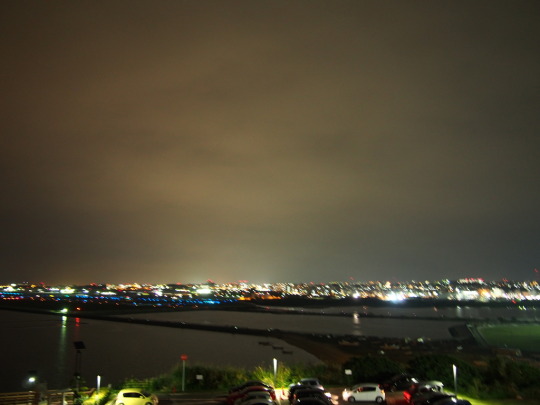
隔天起床

不過這裡真的可以看到很多飛機!
IR大約有一個多鐘頭都坐在陽台看飛機~
ANA超多~偶爾也會看到日本軍機
飛機控們這裡你們會愛!

這次訂的房型為
★ 標準雙人間(機場景觀)
スタンダードツインルーム【エアポートビュー】
Standard Twin Room (Airport View)
兩張小床的房型

飯店會提供一人兩套衣服、與兩雙鞋子。
一套為館內行走服與鞋子。可以去洗溫泉的時候穿去。
另一套為睡衣與拖鞋!
有一個小客廳,客廳外是一個陽台

陽台風景~大家也可選擇海景房~就不會看到停車場之類的~
不過要看飛機就要選擇看機場的房型唷!

這裡的海景很厲害,可惜我們來的日子陰陰的
這裡的海景房,有的還有附房內溫泉,可以在房間裡邊泡溫泉邊看風景唷!

書桌與化妝台- 這個集團都有提供平板讓客人可以輕易了解飯店設施等資料。
在mini bar內還有提供沖繩小點心與黑糖,飲料有日本咖啡、煎茶等等。
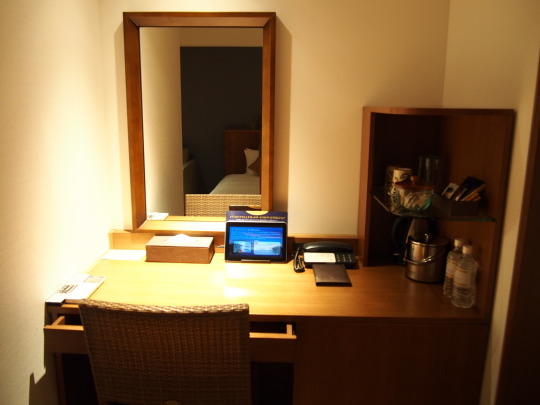
這裡的衛浴設備有把廁所與浴間分開

澡盆很深很不錯^^

[
這裡的溫泉也相當優秀
龍神的湯
這裡有分為金湯與銀湯的澡堂,男湯與女湯會每日交換。
-> 裡面可以泡 ->->
■ 立湯- 兩種湯裡面都有,可以站立著泡,站在湯裡會有種,全身輕盈感。身上的肉肉會有浮上來變挺的感覺哈哈~
■ 壺湯- 兩種湯裡面都有,共三個紅色的大水缸(?)一個人泡剛剛好,會全身浸在裡面。
■ 岩風呂- 金湯銀堂的其中一個會有,水池事由岩石組成的,有時候裡面會有很多藻類一起~據說對皮膚的保濕力很優唷!
■ 寢湯- 水池裡有做一個斜坡,能夠躺在上面,不過會一直飄起來~哈哈
■ 內湯- NANO TECH的水,是一中非常微小的水分子….. 有時候這個池子會放入一些特別的小花、藥草或是小鴨鴨
■ 三溫暖烤箱- 就是熱熱的三溫暖烤箱~
■ 三溫暖+鹽- 提供鹽讓大家在三溫暖烤箱內搓搓去角質^^
這裡的湯~IR很推唷!
另外可以從泡湯的地方看到海景唷!

■ 飯店名稱: 琉球温泉 瀬長島ホテル Ryukyu Onsen Senagajima Hotel
■ 地址: 〒901-0233 沖縄県豊見城市字瀬長174-5
■ TEL: 098-851-7077
■ WebSite: http://www.hotelwbf.com/senaga/index.html
■ Facebook: https://www.facebook.com/senagaspa?ref=hl
IR的粉絲專頁! 請幫我按讚!!

0 notes
Photo
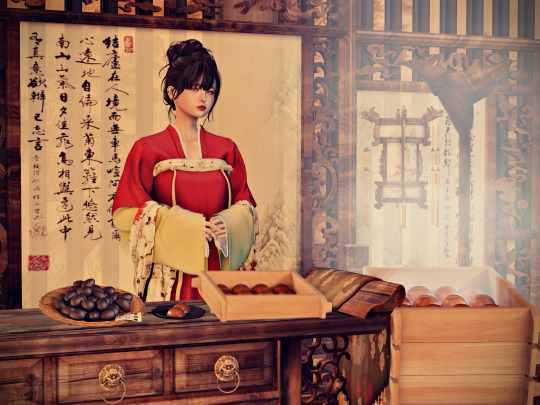
That's what I said,
A girl worth fighting for...
I want her paler than the moon,
With eyes that shine like stars
My girl will marvel at my strength,
Adore my battle scars.
I couldn't care less what she'll wear or what she looks like.
It all depends on what she cooks like.
- Mulan
🌺 Black Egg - Mamere
Dispenser
Auto attach
Bento eating animation
4 LI
🌺 Onsen Manju Set
Dispenser (black plate)
Auto attach
Bento eating animation
1 LI
🌺 Onsen Manju Steamer
Dispenser
Auto attach
Bento eating animation
2 LI
Available from the RyuKyu Onsen Event From the 1st Feb
[Mamere] Mainstore
[Mamere] on Marketplace
0 notes
Text
Trump: the View from Japan
I arrived in Japan on July 24, 2016. The election was on everyone’s minds, but at that point it was still cloaked in banality. Hillary would of course win, and Trump would go on to expand his business interests and perhaps start his own right-wing TV channel. Most people were talking more about the sellout of the Democratic Party than the much more frightening—absurdly frightening, impossibly frightening—alternative.
I woke up on November 10 (due to the time change) expecting to go into work, check my phone for the announcement of Hillary’s victory, and have a generally pleasant day. Reports I read in the morning signaled that this would all happen very quickly, over before Japan’s lunch time. The New York Times presidential probability meter had Hillary somewhere in the low 80s. Trump had made some inroads in previous days, but he never got much more than a 25 percent probability. Nate Silver offered more chilling odds, but I wrote them off as due diligence. Somebody had to present the negative alternative.
At work I sat down at my desk and watched the New York Times map to see the results coming in. The first few states along the east coast were predictably cobalt. Maryland, Vermont. But then came Virginia. On the Times map it stayed red for a long time, too long. Why was Tim Kaine’s home state so red? Why did it take so long to turn blue? Then came Florida—red. North Carolina—red. These were supposed to be the trophies of Hillary’s glorious victory lap.
My anxiety was spiking. My eyelid started twitching. At lunch I went to my favorite udon restaurant, where I clutched my phone in one hand and chopsticks in the other. What the hell is happening. Ohio, Michigan, Pennsylvania, Wisconsin. My best friend in Seattle texted me: “Is Trump our next president?” I shot back: “I think he might be. If she can’t stop the bleeding in Michigan and Wisconsin soon, it’s over.”
She didn’t stop the bleeding. That afternoon I watched in despair as she took the stage in her shimmering purple suit, Bill on her right and Kaine on her left. What was she doing? What was President Hillary doing? She was letting us know that there would be no President Hillary.
***
I have spoken to only one Japanese citizen who supports Trump. He is 20 and a college student. He referenced his desire to see someone “shake up the system,” and he said he would rather have anyone in power than “that bitch.” Other than him, every single person I have spoken to—from first graders to old men—has expressed horror at the thought of Trump.
Leading up to November 9, students in all of my classes asked me who I would be supporting. When I said Hillary they smiled and high-fived me—“Okay!” A sense of relief would immediately settle and we could get on with class. This happened over and over, with first graders all the way up to ninth graders. Still, in the aftermath of the inauguration, the kids ask me and wait for my answer. Hillary. “Okay!”
A few days before the election, one of my coworkers at school asked me who I supported. When I said Hillary, she agreed. “Peace,” is all she said. “Peace.”
I met two old men from Osaka at an onsen in my town. They offered me a soda and I sat with them while they smoked. One of the old men was drunk, had a coughing fit, and fell asleep. His friend smiled at me, and I got the feeling this was not an unusual situation. The upright man then mentioned Trump, and his friend bolted out of his stupor. I didn’t catch most of what he said, but I heard enough to deduce he was talking about Okinawa. Trump has said that Japan should pay more to house the American bases on Okinawa, even though it already bears the majority of the costs.
“And he wants us to pay more!”
The indignity of the suggestion—taken within this country of great dignity—rattled in the air. It was beyond audacious to suggest that the people of Japan and Okinawa—the former Ryukyu kingdom, client of China, annexed by Japan in the 1800s, occupied by the Americans after World War II—should incur even more costs to support a colonial outpost whose main function is to anchor American economic dominance in east Asia.
Within Okinawa there is strong resistance to the American occupation and much debate surrounding the question of whether the bases have outlived their strategic purpose. The question of Okinawa, a unique culture within Japan, has been a source of tremendous tension in Japanese politics for generations. Hundreds of kilometers away from the island, though, speaking of Okinawa, my Japanese teacher said: “We are afraid of losing the base. It offers protection.”
Presumably that protection is from North Korea and the looming specter of a confrontation with China. Japan is the only place in the world where nuclear weapons have been deployed in military attacks, wiping out so many thousands of lives in two flashes. The idea that those horrors may return is a lingering consideration here. And yet on TV, stomping into the White House is a man treating a military base in Japan like an Atlantic City casino, a man saying that more nukes wouldn’t be such a bad idea, that a war in east Asia wouldn’t really be an American concern.
“Good luck, enjoy yourself, folks.”
A Japanese friend of mine kept using the same word to describe what happened: disappointment.
My students ask me two questions about the United States over and over. The first: Do I own a gun? The second: Have I been to Trump Tower?
***
The yen tumbled after the election but is slowly climbing back up. The Japanese economy, though, has been in a state of stagnation for decades. Japanese Prime Minister Shinzo Abe’s right-wing government probably stands to benefit a good deal of legitimacy from a far-right American order. Abe, an unpopular but not infuriating figure in Japan, looks much more statesmanlike in contrast to the new president. The fall of TPP was a blow to his government, but in the longterm I wonder how he will position himself in contrast to the chaos across the Pacific.
In 2020 Americans will choose their president. Also in 2020, Tokyo will host the Olympic games. All levels of Japanese government are involved in preparation for the games, which are being promoted as the dawn of a new era for an economically languishing Japan, its reintroduction to the world. Efforts to “internationalize” are in full swing, with English instruction ramping up throughout the country.
Following the election, Abe was the first world leader to visit Trump. Apparently he had already planned a visit for February, with Clinton. But after the election he moved his U.S. visit dramatically up, to that very week.

The photograph of Trump and Abe (along with their aides and, for whatever reason, Ivanka) in Trump’s rococo Manhattan lair is an incredible artifact. It shares a visual vocabulary not with the American presidency but with a spasming dictatorship—more Saddam-in-Baghdad than Yalta Conference. The bad lighting, the camera flash reflecting off of the window, the untouched bottled waters (sparkling and flat), the decadence and tackiness of the whole scene, an impossibly heavy coffee table, marble everything, a gigantic urn, the beige carpet, a candelabra with never-burnt candles blocking the face of Abe’s aide, the ridiculous camera angle making it appear as though someone just stumbled onto something pretty neat, but not somewhere they are supposed to be. There is Trump, sinking into his couch, his legs wiggling from the cushions. There is Abe, leaning forward, listening politely. And there, for some reason, is Ivanka, close to the camera, as though she will turn at any moment to shoo us away from this private encounter. Decadent: rotting, dripping, glimmering.
Trump looks so comfy and proud on his big couch. Ivanka looks the way she always does, managing the big baby that is her father. And there’s Abe. He beat the world to that shimmering, rotting pile of a living room. In my fantasy, Ivanka shoos us away, but Abe turns toward us—as we board the elevator—and winks.
0 notes